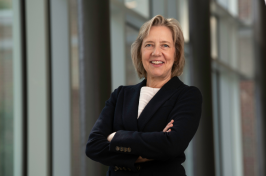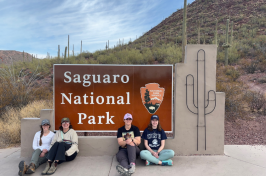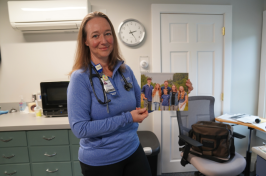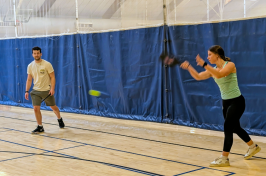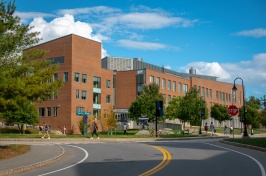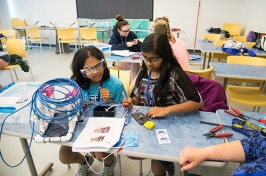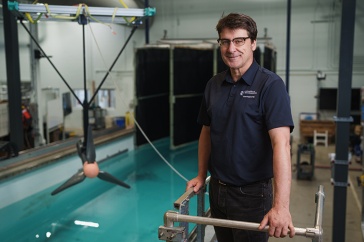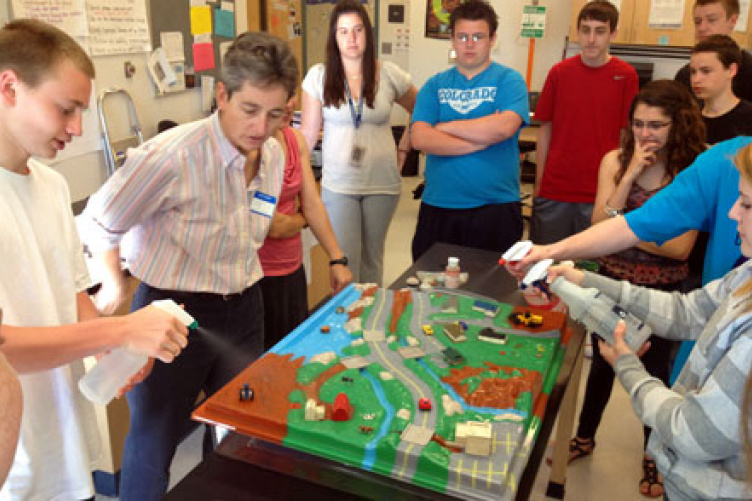
Students study a watershed model from the Dept. of Environmental Services.
"Science is dirty!" "It’s too hard!" "We don't have the tools we need!" Sound familiar? These were a few of the comments by sophomores from Sanborn Regional High School working at local Powwow Pond as part of an intense semester long project.
Sarah Sallade, ’06G, ’12G, a 10th grade Life Science teacher at Sanborn, says that such complaints naturally arise when students experience what it's like to be out in the field collecting their own data – sans the spoon feeding of information they are accustomed to. “In real life, doing research is messy, you don't always have all of the information or funding for the most advanced resources, and sometimes you have to improvise,” says Sallade, who holds master’s degrees in both natural resources and education from UNH. “This project is interesting because it's a different approach," says Sallade.
And she would know. Her master's research involved carbon cycling of forests of the northeastern U.S. From 2006-2012, Sarah primarily worked to translate terrestrial carbon cycle research into hands-on educational and student research activities for K-12 classrooms. In collaboration with the international GLOBE education program, she traveled locally and globally to train teachers and teacher-trainers on the Carbon Cycle project materials. She is now a practicing GLOBE teacher at Sanborn Regional High School in Kingston, NH.
The ecology project at Powwow Pond focused on the impaired and nutrient overloaded body of water in Kingston. It combined three sophomore classes: Biology, Government and Economics, and English. Students worked with property owners, the Powwow Pond Council (PPC), and the Kingston Conservation Commission (KCC) to study the different laws and regulations that govern environmental protection. They also wrote educational flyers on topics such as fertilizer usage and impacts of storm water.
“It gets our students out in the community and working on a project that impacts them or their neighbors," observes Sanborn Regional High School Principal Brian Stack. And the project involved much more than that. It started with a dedicated group of teachers who worked as a team in collaboration with the KCC and the PPC to design, coordinate and map out the semester-long activities that would result in a set of solutions the students could implement to help the pond.
|
...then move their research to the real thing. |
Evelyn Nathan of KCC and Diane Coll of PPC started by gaining permission for 180 students to access several private properties around the lake where the students took measurements and samples of soil and water, drew diagrams and photo documented the area. Teachers then recruited local experts to come to the school and present. Suzanne Petersen, the Lamprey River Advisory Committee outreach coordinator, worked with the Department of Environmental Services watershed model in the biology lab: affording students the chance to explore how the land surrounding streams, rivers and lakes acts as a drainage basin or watershed. Michelle Daley, a research scientist from the Department of Natural Resources at UNH, met with students and talked about her career as a scientist studying water quality and the differences between point and non-point source pollution.
Sallade says bridging the gap between the scientific community and the K-12 education community is important because the general public often misunderstands science as a discipline. “Many people do not understand that what we know to be true today is based upon multiple lines of evidence that have been peer reviewed and confirmed by many in the scientific community,” says Sallade. While sometimes there are major shifts in scientific thinking, generally science theories build slowly over time as we gather more evidence. “It’s critically important that this process and understanding of science not only be taught to students but also experienced by them so when they become voting citizens they are able to make informed decisions.”
|
Photo by Allison Wasiewski |
The culmination of the project ended back at Powwow Pond where students spent a day spread out over five properties, where they built infiltration trenches, rain gardens and vegetative buffers that would soak up the water and pollutants and lessen the impact of excess nutrients during future storms and floods.
When asked what she was working on, sophomore Gillian Crane says, "We're filling these trenches with gravel and they are going to act as filters for all the stuff that runs off the road, instead of it going directly into the pond."
Evelyn Nathan, chair of the Conservation Commission in Kingston, put the matter frankly: "We know there is a problem with the pond. One of our goals is to try and use more organic solutions and come at this from a different angle. The students are part of that effort and they are doing an awesome job!"
Written by Evelyn Jones, Communications Coordinator, NH EPSCoR
-
Written By:
Staff writer | Communications and Public Affairs












